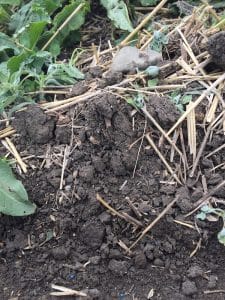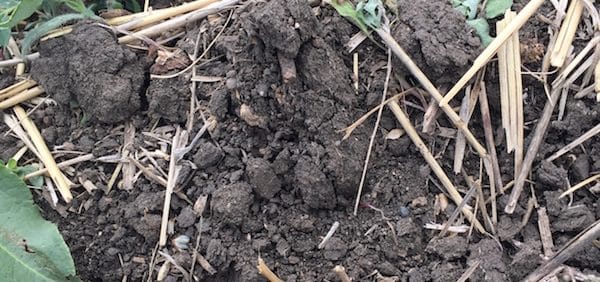Early weed control is preferred because nutrient and moisture taken up by weeds means less for the crop. Weeds emerging before the crop also compete for sunlight, which is an issue if those weeds canopy over the crop.
Ideally, growers want crop emerging in a clean field so it can get ahead of the weed competition. That is why pre-seed and early in-crop control are so valuable.
AAFC research from Scott, Saskatchewan showed that spraying 7 days after crop emergence generated higher yields than spraying 17 days after emergence. Given the value of early management, using a low drift nozzle early to get rid of weed competition can be better than waiting longer for a relatively calm day to use a finer spray.
Here are a few in-crop weed situations and what to do about them:
Winter annuals are large but annuals are just emerging or not emerged yet. These big winter annuals are best controlled early in the pre-seed window because waiting can reduce yields significantly. Also, rates and tank mix options tend to allow for better control because the weeds are smaller then. If a pre-seed application was not done or provided incomplete control (due to cold conditions, insufficient rates or inappropriate tank mix, for examples), an earliest possible in-crop application with the highest label rate may be required to get rid of this costly competition. A second in-crop application in two weeks may be required if annuals emerge after the first application and are getting ahead of the crop.

Winter annuals were controlled with pre-seed but grassy annuals are ahead of the crop. Green foxtail tends to be one of the last annuals to germinate, so their presence indicates that most annuals are popping. If grassy weeds are the only weeds present, a graminicide alone is an option in canola. But if these patches are resistant to a particular herbicide group, choose products from alternative groups. Here are grassy weed control tips for each HT canola system:
—Glufosinate tolerant (Liberty Link): Liberty works best when applied with water volumes of 10 gallons per acre and when temperatures are warm. Most control issues for herbicides that rely heavily on contact activity, such as Liberty, are related to insufficient water carrier volumes or late staging. If wild oats and other grassy weeds emerge before broadleaf weeds, it might be a good option to go in with a Group 1, then follow up later with Liberty. With heavy grass populations, the mix of Liberty plus Select or Centurion works well. If some of the grassy weeds have suspected Group 1 resistance, then definitely make sure to increase the Liberty water volumes. If most have Group 1 resistance, the tank mix won’t help.
—Glyphosate tolerant (Roundup Ready): Make sure you use the 180 ae/ac rate of glyphosate if you are going in early to control grassy weeds so you still have the option for a second pass if needed.
—IMI tolerant (Clearfield): Odyssey Ultra (Odyssey + Poast Ultra) provides the broadest range of grassy weed control for Clearfield canola. It controls grassy weeds up to the 6-leaf stage of the weed, and the application window is up to the 6-leaf stage of the crop. Odyssey Ultra has three active ingredients: Imazamox – Group 2, Imazethapyr – Group 2 and sethoxydim – Group 1. Between the 4-leaf/no tiller stage (Odyssey’s maximum stage) and the 6-leaf stage of grass weeds, the Poast Ultra component is carrying the bulk of the load for grass control. Any grasses that are already Group-1 ‘dim’ resistant will not be controlled beyond the 4-leaf stage. Weed biotypes with Group 2 resistance will not be controlled either. Other options for grassy weed control in Clearfield canola are Ares (imazamox + imazapyr), Odyssey (imazamox + imazethapyr) and Solo (imazamox), but each of these opitons is solely Group 2 actives. Salute and Tensile are co-packs that include the equivalent of Lontrel packaged with Ares and Solo (respectively).
You are planning for two in-crop applications. The first early application is the most important. If the crop gets off to a good start, the second may not be necessary. A second application may have no economic value and it can increase selection pressure for resistant weeds. Scout the situation before automatically spraying. A second application can make sense if (1) growers use canola as a clean up crop for Group-1 resistant wild oats, narrow-leaved hawk’s beard, round-leaved mallow and other tough weeds; (2) weeds are plentiful, at the same stage or ahead of the crop and the canopy hasn’t closed, which means they will have a large yield impact (Note: Follow label rates even if these large weeds might require a higher rate for control. Suppression may be sufficient to preserve yield); or (3) weeds are at levels too low to influence yield but species present could impact grade (cleavers, for example).
Clubroot reminder: With moist soil conditions at spraying, mud on sprayer tires can spread clubroot. Think sanitation.
Further reading:
12 tips for better spraying results
Herbicide mixes may be needed on HT canola

